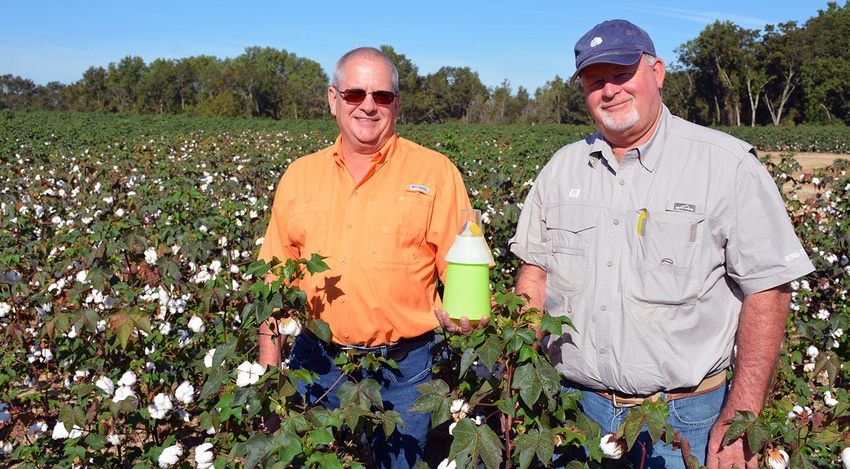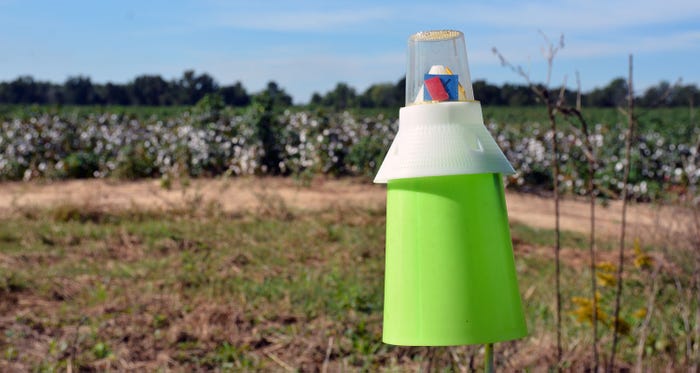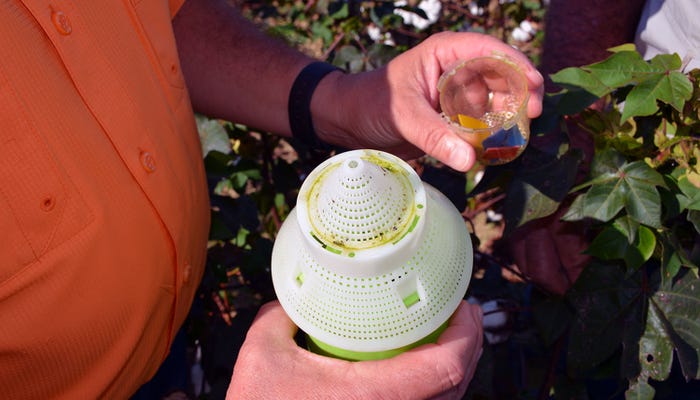
Alan Lowman picked up the smart tablet, made a few swipes on the screen. The map popped up. There was one just up the road that would be good to go check.
Just outside the southwest Georgia cotton field, the yellowish-green cone sat atop the fiberglass stake about three feet off the ground. "Stand back," Lowman said.
He pulled down on the cone, bending the fiberglass stake to the ground and let it go. The stake and cone whipped back and forth but all remained intact. "Putting the stake deeper and the trap lower to the ground was something Hurricane Michael taught us," Lowman said.
Lowman heads up the Georgia Boll Weevil Eradication Program, a post he started in 2018, the same year a category 5 hurricane brought a bunch of bad to the region, including devastating the cotton crop, and by proximity boll weevil traps. It took six weeks after Hurricane Michael to get back to fields and patch back the system of traps that keeps tabs on cotton's most notorious foe.
"We position the traps strategically across the cotton-producing regions of Georgia to create a safety blanket, so to speak. Each trap is important, and we all rely on them to keep check on something none of us in cotton wants to deal with again, the boll weevil," Lowman said, during a farm visit in early October.

In 2021, the Georgia BWEP installed 11,783 traps, each trap covering 109 acres, for a total of 1.287 million planted acres. (Brad Haire)
The traps have become ubiquitous across cotton farms, so much so that they may go unnoticed to some. A trap's color and posture mimic the plants the boll weevil like and feed on. It has three parts: a cup or bottom, a screen top and a cylinder or collection chamber, where an artificial pheromone is placed to attract the weevils. Weevils land on the outside, crawl inside the cone and can't get out. A strip of insecticide is in there, too, to kill weevils that check it out.
The assessment
Lowman said the program has ran smoothly and affectively for decades in Georgia. When he started heading it up three years ago, he wanted to bring more efficient technology to the program. From his tablet, he can track the movement of each of the staff as they manage and monitor traps across the state and can pinpoint each trap's location, latest condition, and data.
In 2021, the Georgia BWEP installed 11,783 traps, each trap covering 109 acres, for a total of 1.287 million planted acres. The Georgia BWEP program divides the state into 13 districts. Most of those districts are in the southwest corner of the state, where the bulk of the cotton acres are. The program divides each season into eight cycles, with the first being the initial trap installation beginning just after Memorial Day. Traps are checked and serviced six times during the season. The eighth and final cycle is trap retrieval and that begins the second week in November.
The boll weevil eradication program hit its stride in Georgia, as it did across the South, in the late-1980s with an intensive treatment and trapping push. In 1987, the program covered 250,000 acres in Georgia, with a grower assessment of $10 per acre, Lowman said.
It's worth remembering that in 1983 Georgia produced 112,000 bales on 115,000 harvested acres for a 467 pound per acre average. At the time and prior, growers had to apply more than a dozen, and in some cases well over a dozen, insecticide treatments to manage the boll weevil each season.
With the success of the boll weevil program and advancement in seed technology, growers now only put out 2 to 3 insecticide treatments as needed. The assessment in Georgia now is 75 cents per bale. In all, Georgia farmers have invested over $156 million in boll weevil eradication since 1987.

A trap has three parts: a cup or bottom, a screen top and a cylinder or collection chamber, where an artificial pheromone is placed to attract the weevils. (Brad Haire)
The boll weevil was officially considered eradicated from Georgia in 1990. Workers monitoring traps reported 81 boll weevils in 2002. The weevil was nowhere to be found in Georgia in 2003 and hasn't been trapped since. Georgia is forecast, according to the USDA October Crop Report, to produce 2.25 million bales, on 1.16 million harvested acres, with an average yield of 931 pounds per acre.
"Our goal is to keep the program running as efficiently as possible. We go trapping each season, and each year we hope we don't catch anything, but we hope we don't miss anything, too," Lowman said.
Still lives
The boll weevil eradication program currently is a cooperative effort between state and national grower groups and public institutions across the cotton belt, but it was started by growers for growers and is still managed by grower-controlled oversight.
(EDITOR'S NOTE: The boll weevil eradication program in each state has been a success across the Southeast. For this article, we highlight the efforts in Georgia, which is the country's No. 2 cotton producing state. North Carolina farmer Marshall Grant, known as 'Mr. Boll Weevil,' spearheaded the establishment of the program in North Carolina in the late 1970s. When the National Cotton Council backed a full-scale eradication trial, North Carolina was the first location.)
Bart Davis says no one should take the success of the program for granted. The diversified southwest Georgia farmer and current chairman of the Georgia Cotton Commission remembers cotton farming was different back in the early 1980s, when, as a young man, he started farming on his own.
"The people who may not have been around growing cotton back when the weevil was a problem may not understand just how bad it was, or how difficult and costly it was to make cotton profitably in our area at that time. I remember," Davis said. "They may also wonder why we still need the program."
Though eradicated in Georgia for almost three decades, the boll weevil still lives on planet earth, Davis said, and that's why the program remains essential as a check, and so does national cooperation.
Growers in the Lower Rio Grande Valley of Texas still hold the line on the border, where due to location, environment and tough weather, the boll weevil is not yet eradicated. Growers in that Texas zone as of 2015 are assessed $14 per dryland acre and $28 per irrigated acre to fund their eradication program, which still includes an average of 7.65 insecticide applications per season to manage the weevil.
Cotton growers across the country still contribute to the National Boll Weevil Protection Fund. Administered by the National Cotton Council, the NBWPF establishes a buffer to protect eradicated parts of the country from boll weevil reinfestation. Each state's foundation contributes to the national effort. The Texas Boll Weevil Foundation operates the buffer zone along the border. The Texas foundation can petition for reimbursement for the effort from the NBWPF.
Read more about:
Boll WeevilAbout the Author(s)
You May Also Like






